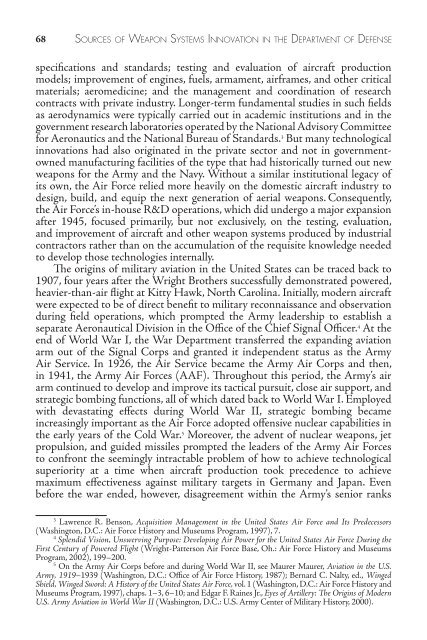To download as a PDF click here - US Army Center Of Military History
To download as a PDF click here - US Army Center Of Military History
To download as a PDF click here - US Army Center Of Military History
You also want an ePaper? Increase the reach of your titles
YUMPU automatically turns print PDFs into web optimized ePapers that Google loves.
68 so u R c e s o f we a p o n sy s T e m s In n o v a T Io n In T h e depaR TmenT o f defense<br />
specifications and standards; testing and evaluation of aircraft production<br />
models; improvement of engines, fuels, armament, airframes, and other critical<br />
materials; aeromedicine; and the management and coordination of research<br />
contracts with private industry. Longer-term fundamental studies in such fields<br />
<strong>as</strong> aerodynamics were typically carried out in academic institutions and in the<br />
government research laboratories operated by the National Advisory Committee<br />
for Aeronautics and the National Bureau of Standards. 3 But many technological<br />
innovations had also originated in the private sector and not in governmentowned<br />
manufacturing facilities of the type that had historically turned out new<br />
weapons for the <strong>Army</strong> and the Navy. Without a similar institutional legacy of<br />
its own, the Air Force relied more heavily on the domestic aircraft industry to<br />
design, build, and equip the next generation of aerial weapons. Consequently,<br />
the Air Force’s in-house R&D operations, which did undergo a major expansion<br />
after 1945, focused primarily, but not exclusively, on the testing, evaluation,<br />
and improvement of aircraft and other weapon systems produced by industrial<br />
contractors rather than on the accumulation of the requisite knowledge needed<br />
to develop those technologies internally.<br />
The origins of military aviation in the United States can be traced back to<br />
1907, four years after the Wright Brothers successfully demonstrated powered,<br />
heavier-than-air flight at Kitty Hawk, North Carolina. Initially, modern aircraft<br />
were expected to be of direct benefit to military reconnaissance and observation<br />
during field operations, which prompted the <strong>Army</strong> leadership to establish a<br />
separate Aeronautical Division in the <strong>Of</strong>fice of the Chief Signal <strong>Of</strong>ficer. 4 At the<br />
end of World War I, the War Department transferred the expanding aviation<br />
arm out of the Signal Corps and granted it independent status <strong>as</strong> the <strong>Army</strong><br />
Air Service. In 1926, the Air Service became the <strong>Army</strong> Air Corps and then,<br />
in 1941, the <strong>Army</strong> Air Forces (AAF). Throughout this period, the <strong>Army</strong>’s air<br />
arm continued to develop and improve its tactical pursuit, close air support, and<br />
strategic bombing functions, all of which dated back to World War I. Employed<br />
with dev<strong>as</strong>tating effects during World War II, strategic bombing became<br />
incre<strong>as</strong>ingly important <strong>as</strong> the Air Force adopted offensive nuclear capabilities in<br />
the early years of the Cold War. 5 Moreover, the advent of nuclear weapons, jet<br />
propulsion, and guided missiles prompted the leaders of the <strong>Army</strong> Air Forces<br />
to confront the seemingly intractable problem of how to achieve technological<br />
superiority at a time when aircraft production took precedence to achieve<br />
maximum effectiveness against military targets in Germany and Japan. Even<br />
before the war ended, however, disagreement within the <strong>Army</strong>’s senior ranks<br />
3 Lawrence R. Benson, Acquisition Management in the United States Air Force and Its Predecessors<br />
(W<strong>as</strong>hington, D.C.: Air Force <strong>History</strong> and Museums Program, 1997), 7.<br />
4 Splendid Vision, Unswerving Purpose: Developing Air Power for the United States Air Force During the<br />
First Century of Powered Flight (Wright-Patterson Air Force B<strong>as</strong>e, Oh.: Air Force <strong>History</strong> and Museums<br />
Program, 2002), 199–200.<br />
5 On the <strong>Army</strong> Air Corps before and during World War II, see Maurer Maurer, Aviation in the U.S.<br />
<strong>Army</strong>, 1919–1939 (W<strong>as</strong>hington, D.C.: <strong>Of</strong>fice of Air Force <strong>History</strong>, 1987); Bernard C. Nalty, ed., Winged<br />
Shield, Winged Sword: A <strong>History</strong> of the United States Air Force, vol. 1 (W<strong>as</strong>hington, D.C.: Air Force <strong>History</strong> and<br />
Museums Program, 1997), chaps. 1–3, 6–10; and Edgar F. Raines Jr., Eyes of Artillery: The Origins of Modern<br />
U.S. <strong>Army</strong> Aviation in World War II (W<strong>as</strong>hington, D.C.: U.S. <strong>Army</strong> <strong>Center</strong> of <strong>Military</strong> <strong>History</strong>, 2000).

















